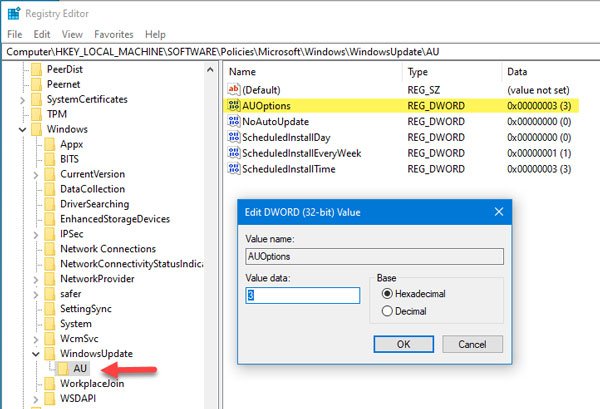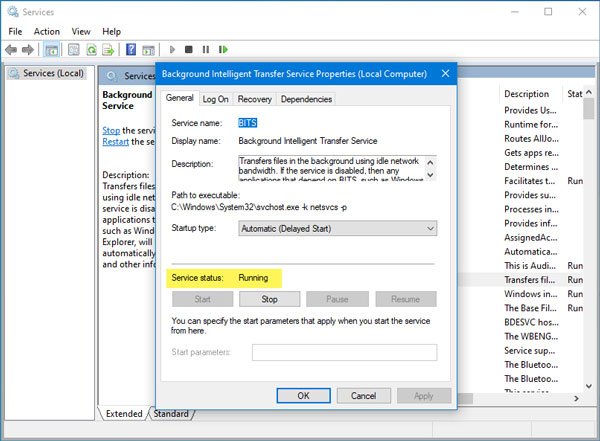If your administrator has disabled Windows Updates or due to a corruption of automatic update settings, you may receive an error message Your organization has disabled automatic updates in Windows 10 settings. If you see this error message when you try to check for updates, this message will help you resolve the problem.
Windows 10 automatically checks for updates and installs them in the background so users don’t miss anything when they’re busy with their daily work. However, when you see this message, Windows 10 will not automatically download updates.
The other messages you see would be:
Your organization has disabled automatic updates
The reasons why this message might appear are-
- The system administrator has defined this policy
- Choosing incorrect automatic update settings in Group Policy
- Setting incorrect value data for AUOptions in Registry Editor
- Your system could be infected with malware
Solve Your organization has disabled automatic updates error in Windows 10, follow these steps-
- Restore the default settings of Configure Automatic Updates in the Local Group Policy Editor
- Edit AUOptions value data in Registry Editor
- Start the smart transfer service in the background
- Activate Windows Updates from Services
All of these are mentioned below in detail. To do this, you must be logged in with an administrator account.
1]Restore default settings of Configure Automatic Updates
If you are using Windows 10 Home edition, you will not have the local Group Policy editor. If you are using other versions, this step is essential for you as it could be the main reason why Windows update process is interrupted. You must open the Local Group Policy Editor on your computer.
To do this, press Win + R, type gpedit.msc and hit the Enter button. Then go to the following path:
Computer Configuration > Administrative Templates > Windows Components > Windows Update
On your right, you should find a parameter called Configure automatic updates.
You must double click on it, select Not configuredand save your change.

After that, check whether you can get updates or not.
2]Edit AUOptions value data in the registry
AUOptions or Automatic Updates Options is an essential registry key for managing Windows 10 updates. In other words, this registry key is equivalent to the above Group Policy setting. If your operating system does not have the Local Group Policy Editor, you must open the Registry Editor and make the necessary changes. Before that, it is recommended that you create a system restore point first.
hurry Win + R, type regedit and hit the Enter button. You must click the Yes option in the UAC window. After opening the Registry Editor, go to this path-
ComputerHKEY_LOCAL_MACHINESOFTWAREPoliciesMicrosoftWindowsWindowsUpdateAU
On your right, you should get a REG_DWORD key named AUOptions. You must change the value data for this key.
- 2 – Notify for automatic download and installation
- 3 – Automatic download and installation notification
- 4 – Automatic download and installation planning
- 5 – Allow local administrator to choose the setting
Double click on the AUOptions and set the value to 0 and see if it helps.

If that doesn’t help, you can delete the Windows Update key on your left side and check for updates.
For your information, the WindowsUpdate key appears when your system changes the default Windows Update settings. In other words, you can restore the default update settings by removing the WindowsUpdate key from Registry Editor.
3]Start the smart transfer service in the background
BITS or Background Intelligent Transfer Service is an essential component to run Windows Update, etc. If this service is not running in the background, your system will not move the data using idle network bandwidth. Therefore, the Windows Settings panel displays the error when checking for updates. It is recommended to make sure that the BITS works, or if not, you have to start it.
Open Service Manager and find the Background Intelligent Transfer Service option in the Name column and double-click it. Now make sure the Service status shows Operation. Otherwise, select Automatic or Automatic (delayed start) of Startup type drop-down list and then click on the beginning button.

Then you can click the Apply and OK buttons to save the changes.
4]Activate Windows Updates from Services
For many people, Windows updates are a big headache, although it is good practice to install various patches from time to time. There are several tools and methods for disabling automatic Windows Update on Windows 10. If you used Service Manager to do your work, you need to make sure that the Windows Update service is running in the background.
To do this, follow the same steps as those mentioned above to first open the Services window. After that, open the Windows Update service and check if the Service status watch Operation or not. If it indicates something negative, you must click on the beginning button to make it work.
If these solutions do not work, it is suggested to run the Windows Update troubleshooter and scan your PC with a trusted antivirus.
- Keywords: Troubleshooting, Windows Updates
